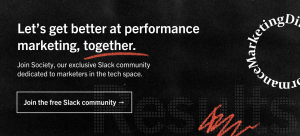How many types of display ads are you experimenting with in your digital marketing campaigns?
While ads in the Google Search Network are usually restricted to just a few lines of text, display ads can be presented in a variety of formats and sizes.
Digital marketers can choose between standard display creative, such as banner ads, or a range of rich media alternatives. Rich media ads are display ads that use HTML5 technology to deliver advanced features like video, audio, expansion or polling. Rich media offers a more engaging experience that helps capture the attention of your target audience and drive conversions
So, why is it important to use different types of display ads in your PPC campaigns?
You may have heard of a phenomenon called “banner blindness“. The term was coined in 1998 after a study where it was found that many participants tended to ignore banner-like information when scrolling through a website. Researchers postulated that after being exposed to thousands of banner advertisements, users would simply learn to ignore them and focus their attention on the contents of the page.
For digital marketers, that makes it extra important to experiment with new types of display Ads that can capture the attention of the target audience. If you’re depending solely on static banner ads, it’s more than likely that a huge portion of your audience is simply tuning you out. By learning how to create display ads with rich media, you can offer new experiences that overcome banner blindness and expand awareness for your brand.
To help you incorporate more types of display Ads into your Google display campaigns, we’ve created a list of the eight most important ones you need to know. As you read through, think about how each of these types of display ads deals with the phenomenon of banner blindness.
8 Types of Display Ads You Should Know
Static / Standard Banner Ads



Images courtesy of Bannersnack
A banner is a simple image ad that is served onto a web page. Static banner ads typically consist of a single image file with no audio, video or additional features.
The first static banner ad was published online in the October 1994 edition of the web-based magazine HotWired. It linked to a series of filmed virtual museum tours and it had classic click-bait ad-copy: Instead of showing the company’s logo, the banner simply said “Have you ever clicked your mouse right HERE? YOU WILL”. The ad was reported at the time to have a 44% click-through rate.
While standard banner ads are still commonly used, other forms of display advertising may be preferable for optimizing click-through rate and making the best use of costly ad space.
Animated Ads
Animated ads are a cut above static banner when it comes to capturing the attention of the target audience. Animation creates movement that naturally catches the eye and works against banner blindness, prompting target audiences to investigate your creative. Animations can also be combined with audio to create long-form ads that offer deep or complex explanations about a product, process or problem.
Another great aspect of animated ads is that they can offer an additional layer of humor and fun that makes them more share-able than a typical banner ad. Animals make it easier to create a narrative that the target audience can easily connect with.
Here’s one example of an animated advertisement for the meditation app HeadSpace. This animation is informative, fun, and constructs a clear narrative around the product and its benefits.
Here’s another animated advertisement for a roof replacement service that uses the fast draw animation technique.
You can also check out this video ad for Planet Fashion that uses stop motion animation.
Interactive Ads

Images courtesy of AdWeek
Interactive advertisements provide embedded features that allow the audience to immediately interact with the product or service.
One example of interactive advertisement is Playable ads. Ads for mobile video games are often play-able, allowing users to test out a miniature demo of the game interface that’s embedded into the ad. Playable ads are often displayed in other mobile games or on gaming websites. Major brands like Wheat Thins and McDonald’s have produced their own playable display advertisements to capitalize on this trend and increase brand awareness.
Other interactive ads may ask users to fill out a lead form or respond to a poll in exchange for access to gated content.
We’ve also seen interactive advertisements with coloring book functionality – the ad appears in black and white coloring and users are invited to interact with the ad by coloring in the images.
Video Ads
While video ads are primarily served through video content platforms like Netflix and YouTube, they can also be distributed through display ad networks & social ad networks.
The great thing about video advertising today is that almost everybody has access to a mobile phone with reasonably high-quality video capture capabilities. There are thousands of people shooting, editing and publishing video-based content, advertisements included, on nothing more than a mobile phone.
Consumers love video ads right now. YouTube is the second-largest search engine on the Internet and people spend 33% of their time online engaging with video content. Videos also perform well on both handheld and desktop devices, they’re easy to share, and many marketers have achieved higher engagement rates with video than with traditional image ads.
Expandable Ads


Images courtesy of Google
Expandable Ads are rich media advertisements that can be expanded beyond the original size of the ad unit. Some expandable ads can be configured to expand automatically when a page loads. Others will expand following a user-initiated interaction.
Expanded ads start off in the “invitation state” where they occupy a relatively small ad unit on the page. After initiation, the Ad moves into the “expanded state” and takes up more space on the page, often doubling or tripling in size.
Expandable display ads are still relatively uncommon, although they are being increasingly deployed on both desktop and mobile display networks. Some digital marketers consider Expandable Ads too disruptive to the user experience, but they do a great job of overcoming banner blindness and can perform better than standard banner ads.
Lightbox Ads

Image courtesy of Instapage
Lightbox Ads are an expandable ad format that was introduced by Google in 2012 for use on the Google Display Network.
Lightbox Ads start off looking just like a standard ad unit, but when a user hovers their cursor over one, it expands into a full-screen canvas takeover ad that can include video, audio, animation and other features. To reduce accidental engagements, users must hover their mouse over a lightbox ad for two full seconds to trigger the expansion.
Lightbox ads provide an immersive experience that brings users away from the web page they were browsing and into a full-screen advertising experience.
Interstitial Ads

Image courtesy of Instapage
Interstitial Ads are one of the types of display ads that have grown in popularity with the rise of mobile technology.
Interstitial advertisements are full-screen ads that cover the interface of a host application. They appear during transition points that naturally occur while users engage with the app.
Interstitial ads are commonly featured in mobile games like Bejeweled. Each time a user completes a level, they must sit through a loading screen before starting the next level. Interstitial ads are often presented during these loading screens. Users on the free version of the app may be required to view ads for a set time frame, while some users may pay a one-time fee to remove interstitial ads from their platform experience.
Either way, interstitial ads are one of the leading methods for monetizing mobile games and applications.
360-Degree Video Ads
360-Degree Video Ads are one of our favorite types of display ads to engage with online.
While video ads tell a story from a specific angle and perspective, a 360-degree video ad is a kind of virtual reality that invites your target audience member to play a more active role in engaging with the content. 360-Degree video ads respond to the gyroscopes in the phones of mobile users, so they interact with the ads directly by rotating their phones or moving through space.
Here’s just one example of what you can do with 360-degree video: shoot an elephant safari! You can engage by dragging the video with your mouse on desktop, or with your mobile phone touchscreen.
You will need some specialized equipment (both hardware and software) to get started, but the possibilities are endless for creating high-performing display campaigns with 360-degree video.
Summary
Display ads are a powerful tool that can help businesses reach their target audience and drive conversions. By utilizing various types of display ads such as static images, dynamic ads, video ads, and native ads, tech companies can create engaging and personalized campaigns that effectively communicate their brand message. However, it’s important to keep in mind that successful display advertising requires a strategic approach that takes into account factors such as audience targeting, ad placement, and ad creative. By incorporating these best practices and experimenting with different types of display ads, you can create effective campaigns that achieve your marketing goals!
If you want to take your paid media efforts to the next level, you can count on our expert tech marketing team to get you there. We specialize in Customer Generation and have a proven track record of delivering exceptional results for our clients.
Book a call with us today to find out how you can gain a competitive edge in the world of PPC with Customer Generation.
-
CEO Garrett Mehrguth
Did you enjoy this article?
Share it with someone!



